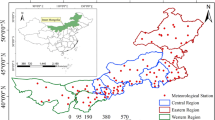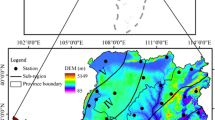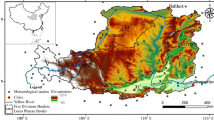Abstract
Potential evapotranspiration (ET o) is important to hydrological cycling and the global energy balance. Based on a modified FAO56-Penman-Monteith model, ET o was simulated for 603 meteorological stations across China in the period 1971–2008. Spatial distribution and temporal change of ET o were characterized, and the determining factors in ET o were revealed by sensitivity analysis. Results show obvious regional differences in annual average ET o and its determining factor. In general, annual average ET o decreased in the period 1971–2008, but increased since the 1990s. Wind speed and sunshine duration were determining factors in the annual ET o trend, with smaller contributions from relative humidity and temperature. Declining wind speed was the determining factor in decreasing annual ET o in northern temperate regions and the Tibetan Plateau. The spatial extent of wind speed influence contracted to northwest China in summer, and expanded to the whole country in autumn. Decreasing sunshine duration was the determining factor in decreasing annual ET o in subtropical and tropical regions, especially in summer, with a larger spatial influence mainly to the southeast of the farming-pastoral region. ET o change has distinct impacts on earth surface ecosystems and environment depending on different determining factors.
Similar content being viewed by others
References
Solomon S, Qin D, Manning M, et al. Climate Change 2007: The Physical Science Basis, Contribution of Working Group I to the Fourth Assessment Report of the Intergovernmental Panel on Climate Change. Cambridge and New York: Cambridge University Press, 2007
Zuo D K. A Modern Dictionary of Geography (in Chinese). Beijing: Commercial Press, 1990
Brutsaert W, Parlange M B. Hydrologic cycle explains the evaporation paradox. Nature, 1998, 396: 29–30
Chattopadhyay N, Hulme M. Evaporation and potential evapotranspiration in India under conditions of recent and future climate change. Agric For Meteorol, 1997, 87: 55–73
Cohen S, Stanhill G. Evaporative climate changes at Bet-Dagan Israel, 1964–1998. Agric For Meteorol, 2002, 111: 83–91
Golubev V S, Lawrimore J H, Groisman P Y, et al. Evaporation changes over the contiguous United States and the former USSR: A reassessment. Geophys Res Lett, 2001, 28: 2665–2668
Hobbins M T, Ramirez J A, Brown T C. Trends in pan evaporation and actual evapotranspiration across the conterminous U.S.: Paradoxical or complementary? Geophys Res Lett, 2004, 31: L13503
Lawrimore J H, Peterson T C. Pan evaporation trends in dry and humid regions of the United States. J Hydrometeorol, 2000, 1: 543–546
Ohmura A, Wild M. Is the hydrological cycle accelerating? Science, 2002, 298: 1345–1346
Peterson T C, Golubev V S, Groisman P Y. Evaporation losing its strength. Nature, 1995, 377: 687–688
Roderick M L, Farquhar G D. The cause of decreased pan evaporation over the past 50 years. Science, 2002, 298: 1410–1411
Thomas A. Spatial and temporal characteristics of potential evapotranspiration trends over China. Int J Climatol, 2000, 20: 381–396
Yang D W, Sun F B, Liu Z T, et al. Interpreting the complementary relationship in non-humid environments based on the Budyko and Penman hypotheses. Geophys Res Lett, 2006, 33: L18402
Roderick M L, Hobbins M T, Farquhar G D. Pan evaporation trends and the terrestrial water balance. II. Energy balance and interpretation. Geogr Compass, 2009, 3: 761–780
Stanhill G, Cohen S. Global dimming: A review of the evidence for a widespread and significant reduction in global radiation with discussion of its probable causes and possible agricultural consequences. Agric For Meteorol, 2001, 107: 255–278
Liu B H, Xu M, Henderson M, et al. A spatial analysis of pan evaporation trends in China, 1955–2000. J Geophys Res, 2004, 109: D15102
Gao G, Chen D, Ren G, et al. Spatial and temporal variations and controlling factors of potential evapotranspiration in China: 1956–2000. J Geogr Sci, 2006, 16: 3–12
Zhang F M, Shen S H. Spatial distribution and temporal trend of reference crop evapotranspiration in China (in Chinese). J Nanjing Inst Meteorol, 2007, 30: 705–709
Pryor S C, Barthelmie R J, Young D T, et al. Wind speed trends over the contiguous United States. J Geophys Res, 2009, 114: D14105
McVicar T R, Van Niel T G, Li L T, et al. Wind speed climatology and trends for Australia, 1975–2006: Capturing the stilling phenomenon and comparison with near-surface reanalysis output. Geophys Res Lett, 2008, 35: L20403
Ren G Y, Guo J, Xu Z M, et al. Climate change of China’s mainland over the last half century (in Chinese). Acta Meteorol Sin, 2005, 63: 942–956
Wang Z Y, Ding Y H, He J M. An updating analysis of the climate change in China in recent 50 years (in Chinese). Acta Meteorol Sin, 2004, 62: 228–236
Zhang X Q, Ren Y, Yin Z Y, et al. Spatial and temporal variation patterns of reference evapotranspiration across the Qinghai-Tibetan Plateau during 1971–2004. J Geophys Res, 2009, 114: D15105
Burn D H, Hesch N M. Trends in evaporation for the Canadian Prairies. J Hydrol, 2007, 336: 61–73
Shen S H, Sheng Q. Changes in pan evaporation and its cause in China in the last 45 years (in Chinese). Acta Meteorol Sin, 2008, 66: 452–460
Roderick M L, Farquhar G D. Changes in New Zealand pan evaporation since the 1970s. Int J Climatol, 2005, 25: 2031–2039
Zhang Y Q, Liu C M, Tang Y H, et al. Trends in pan evaporation and reference and actual evapotranspiration across the Tibetan Plateau. J Geophys Res, 2007, 112: D12110
Rayner D P. Wind Run Changes: The dominant factor affecting pan evaporation trends in Australia. J Clim, 2007, 20: 3379–3394
Zuo H C, Li D L, Hu Y Q, et al. Climate trend and its relationship with pan evaporation in China during recent 40 years (in Chinese). Chinese Sci Bull, 2005, 50: 1125–1130
Bandyopadhyay A, Bhadra A, Raghuwanshi N S, et al. Temporal trends in estimates of reference evapotranspiration over India. J Hydrol Eng, 2009, 14: 508–515
Goyal R K. Sensitivity of evapotranspiration to global warming: A case study of arid zone of Rajasthan (India). Agric Water Manage, 2004, 69: 1–11
Allen R G, Pereira L S, Raes D, et al. Crop Evapotranspiration-Guidelines for Computing Crop Water Requirements. Rome: United Nations Food and Agriculture Organization, 1998
Yin Y H, Wu S H, Zheng D, et al. Radiation calibration of FAO56 Penman-Monteith model to estimate reference crop evapotranspiration in China. Agric Water Manage, 2008, 95: 77–84
Sneyers R. On the Statistical Analysis of Series of Observation. Geneve: World Meteorological Society, 1990
Beven K. A sensitivity analysis of the Penman-Monteith actual evapotranspiration estimates. J Hydrol, 1979, 44: 169–190
Gong L B, Xu C Y, Chen D L, et al. Sensitivity of the Penman-Monteith reference evapotranspiration to key climatic variables in the Changjiang (Yangtze River) basin. J Hydrol, 2006, 329: 620–629
Hupet F, Vanclooster M. Effect of the sampling frequency of meteorological variables on the estimation of the reference evapotranspiration. J Hydrol, 2001, 243: 192–204
Rana G, Katerji N. A measurement based sensitivity analysis of the Penman-Monteith actual evapotranspiration model for crops of different height and in contrasting water status. Theor Appl Climatol, 1998, 60: 141–149
McCuen R H. A sensitivity and error analysis of procedures used for estimating evaporation. Water Resour Bull, 1974, 10: 486–498
Lenhart T, Eckhardt K, Fohrer N, et al. Comparison of two different approaches of sensitivity analysis. Phys Chem Earth, 2002, 27: 645–654
Irmak S, Payero J O, Martin D L, et al. Sensitivity Analyses and Sensitivity Coefficients of Standardized Daily ASCE-Penman-Monteith Equation. J Irrig Drainage Eng-ASCE, 2006, 132: 564–578
Yin Y H, Wu S H, Zheng D, et al. Regional difference of aridity/humidity conditions change over China during the last thirty years. Chinese Sci Bull, 2005, 50: 2226–2233
Chen S B, Liu Y F, Thomas A. Climatic change on the Tibetan Plateau: Potential Evapotranspiration Trends from 1961–2000. Clim Change, 2006, 76: 291–319
Xu M, Chang C P, Fu C B, et al. Steady decline of east Asian monsoon winds, 1969–2000: Evidence from direct ground measurements of wind speed. J Geophys Res, 2006, 111: D24111
Wang Y J, Jiang T, Xu C Y. Observed trends of pan evaporation and its impact factors over the Yangtze River basin between 1961 and 2000 (in Chinese). J Nat Resour, 2005, 20: 864–870
Wang H. The weakening of the Asian monsoon circulation after the end of 1970’s. Adv Atmos Sci, 2001, 18: 376–386
Roderick M L, Rotstayn L D, Farquhar G D, et al. On the attribution of changing pan evaporation. Geophys Res Lett, 2007, 34: L17403
Jiang Y, Luo Y, Zhao Z C, et al. Review of research on wind resources changes in China and in the world (in Chinese). Sci Technol Rev, 2009, 27: 96–104
Wild M, Gilgen H, Roesch A, et al. From dimming to brightening: decadal changes in solar radiation at earth’s surface. Science, 2005, 308: 847–850
Wang Y J, Huang Y, Zhang W. Changes in surface solar radiation in mainland China over the period from 1961 to 2003 (in Chinese). Clim Environ Res, 2009, 14: 405–413
Dai A, Karl T R, Sun B, et al. Recent trends in cloudiness over the United States: A tale of monitoring inadequacies. Bull Amer Meteorol Soc, 2006, 87: 597–606
Sun B, Groisman P Y. Cloudiness variations over the former Soviet Union. Int J Climatol, 2000, 20: 1097–1111
Qian Y, Kaiser D P, Leung L R, et al. More frequent cloud-free sky and less surface solar radiation in China from 1955 to 2000. Geophys Res Lett, 2006, 33: L01812
Streets D G, Yu C, Wu Y, et al. Aerosol trends over China, 1980–2000. Atmos Res, 2008, 88: 174–182
Xie X Q, Wang L. Changes of potential evaporation in northern China over the past 50 years (in Chinese). J Nat Resour, 2007, 22: 683–691
Yang Y H, Zhao N, Hu Y K, et al. Effect of wind speed on sunshine hours in three cities in northern China. Clim Res, 2009, 39: 149–157
Author information
Authors and Affiliations
Corresponding author
About this article
Cite this article
Yin, Y., Wu, S. & Dai, E. Determining factors in potential evapotranspiration changes over China in the period 1971–2008. Chin. Sci. Bull. 55, 3329–3337 (2010). https://doi.org/10.1007/s11434-010-3289-y
Received:
Accepted:
Published:
Issue Date:
DOI: https://doi.org/10.1007/s11434-010-3289-y




